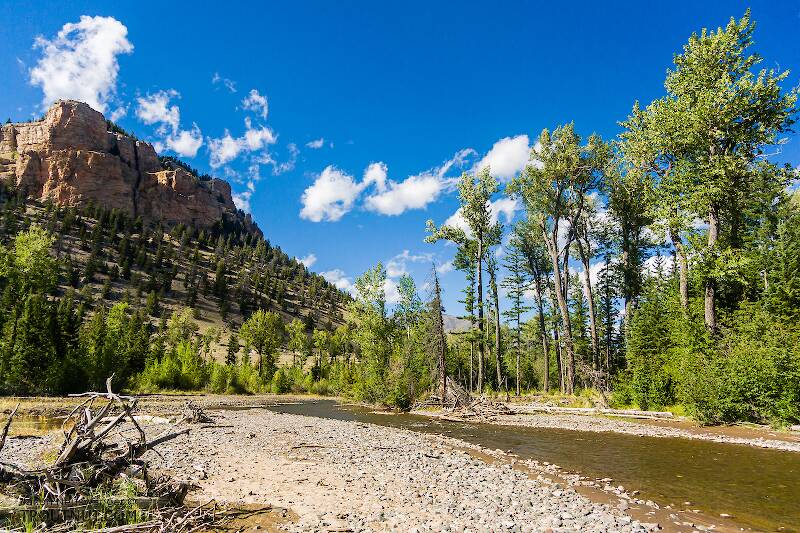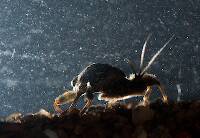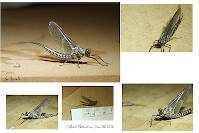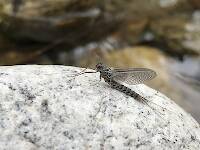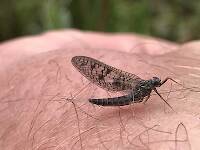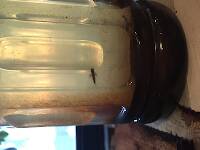
Hex Mayflies
Hexagenia limbata
The famous nocturnal Hex hatch of the Midwest (and a few other lucky locations) stirs to the surface mythically large brown trout that only touch streamers for the rest of the year.
Featured on the forum

This specimen keys to the Epeorus albertae group of species. Of the five species in that group, the two known in Washington state are Epeorus albertae and Epeorus dulciana. Of the two, albertae has been collected in vastly more locations in Washington than dulciana, suggesting it is far more common. On that basis alone I'm tentatively putting this nymph in albertae, with the large caveat that there's no real information to rule out dulciana.

Troutnut is a project started in 2003 by salmonid ecologist Jason "Troutnut" Neuswanger to help anglers and
fly tyers unabashedly embrace the entomological side of the sport. Learn more about Troutnut or
support the project for an enhanced experience here.
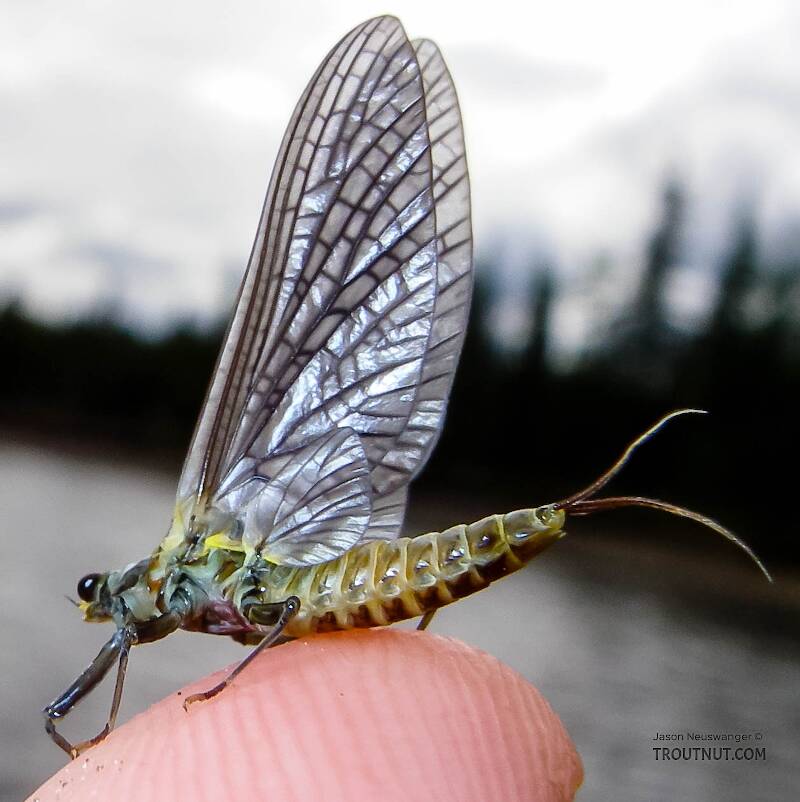
I still haven't got my good camera gear set up, but I wanted to get my first Alaskan bug specimen online, so I photographed this one with my point+shoot in the raft.
DarkDun
Posts: 16
Posts: 16
DarkDun on Oct 19, 2007October 19th, 2007, 5:34 am EDT
No one has mentioned size in these discussions. Is this not relevent?
In the central rockies I fish a size 10 for Grandis and a size 12 for Doddsi and a 14 for Flavilinea and they have to be that if you want to catch big trout. In the east the Lata is mostly a size 16 hook. Glacialis is apparently a size 8 to be fished properly although I have never fished this species.
That is my fly fishers take on Western Green Drakes.
In the central rockies I fish a size 10 for Grandis and a size 12 for Doddsi and a 14 for Flavilinea and they have to be that if you want to catch big trout. In the east the Lata is mostly a size 16 hook. Glacialis is apparently a size 8 to be fished properly although I have never fished this species.
That is my fly fishers take on Western Green Drakes.
DarkDun
Posts: 16
Posts: 16
DarkDun on Oct 19, 2007October 19th, 2007, 5:36 am EDT
No one has mentioned size in these discussions. Is this not relevent?
In the central rockies I fish a size 10 for Grandis and a size 12 for Doddsi and a 14 for Flavilinea and they have to be that if you want to catch big trout. In the east the Lata is mostly a size 16 hook. Glacialis is apparently a size 8 to be fished properly although I have never fished this species.
That is my fly fishers take on Western Green Drakes.
In the central rockies I fish a size 10 for Grandis and a size 12 for Doddsi and a 14 for Flavilinea and they have to be that if you want to catch big trout. In the east the Lata is mostly a size 16 hook. Glacialis is apparently a size 8 to be fished properly although I have never fished this species.
That is my fly fishers take on Western Green Drakes.
GONZO on Oct 21, 2007October 21st, 2007, 7:38 am EDT
DD-
Yes, size does matter. :) However, as an aid to identification (or even imitation) it's just not as reliable or consistent as some fly-fishing texts would lead one to believe. For example, you mention that the Eastern lata that you see are about #16. On Pocono waters, the early lata that I so love to fish (the ones that used to be known as cornuta) are more like a #14, with many of the female duns closer to a standard #12. The later-hatching lata on those waters are about #16, or even #18. That's quite a range of sizes. It just goes to show why careful observation and local knowledge are so important.
By the way, how's the water down in your neck of the woods? It's been low for most of the season in much of the East, but I understand that the Southeast is in especially tough shape.
Best,
Gonzo
Yes, size does matter. :) However, as an aid to identification (or even imitation) it's just not as reliable or consistent as some fly-fishing texts would lead one to believe. For example, you mention that the Eastern lata that you see are about #16. On Pocono waters, the early lata that I so love to fish (the ones that used to be known as cornuta) are more like a #14, with many of the female duns closer to a standard #12. The later-hatching lata on those waters are about #16, or even #18. That's quite a range of sizes. It just goes to show why careful observation and local knowledge are so important.
By the way, how's the water down in your neck of the woods? It's been low for most of the season in much of the East, but I understand that the Southeast is in especially tough shape.
Best,
Gonzo
Entoman on Apr 12, 2012April 12th, 2012, 12:51 pm EDT
They weren't mentioned in this topic, but relative corpulence and silhouette are important (and the easiest) characters useful in telling doddsii apart from the grandis subspecies. Once becoming familiar with these critters streamside, they can be used to identify them at a glance in the adult stages. Though they all have stout thoraxes, it's the abdominal taper where the difference is most obvious. The grandis group (as with the flavilinea group on the other end of the size scale) has the more typical ephemerellid looking abrubt change in diameter from abdomen to thorax and the abdominal taper is much less dramatic where the first four segs are pretty close to the same diameter. With doddsii, the first segment of the abdomen is nearly as stout as the thorax with the rest tapering exaggeratedly to the terminal segs (check the ventral photo of this specimen).
Size is only reliable when compared against the other species groups in a particular watershed. D. doddsii always occupies the middle ground in my experience. This may mean size 12 in one location or a large 10 in another. I have not found characters like color, leg shape, or wing and tail length ratios to be reliable.
D. doddsii adults are perhaps one of the most misidentified species in photos on western flyshop websites (and even in some angler entomologies), which really adds to the confusion.
Nymphs are usually even easier to determine. Many seem to have trouble (probably due to lack of familiarity) and focus on frontal shelves and leg descriptions as provided in dichotomous keys. Others comment that they can't tell unless a ventral is provided showing a suction disk of circular hairs. It's easier than that because none of the large western species (or subs) of this genus are nearly as corpulent and lacking in tergal and head tubercles.
Size is only reliable when compared against the other species groups in a particular watershed. D. doddsii always occupies the middle ground in my experience. This may mean size 12 in one location or a large 10 in another. I have not found characters like color, leg shape, or wing and tail length ratios to be reliable.
D. doddsii adults are perhaps one of the most misidentified species in photos on western flyshop websites (and even in some angler entomologies), which really adds to the confusion.
Nymphs are usually even easier to determine. Many seem to have trouble (probably due to lack of familiarity) and focus on frontal shelves and leg descriptions as provided in dichotomous keys. Others comment that they can't tell unless a ventral is provided showing a suction disk of circular hairs. It's easier than that because none of the large western species (or subs) of this genus are nearly as corpulent and lacking in tergal and head tubercles.
"It's not that I find fishing so important, it's just that I find all other endeavors of Man equally unimportant... And not nearly as much fun!" Robert Traver, Anatomy of a Fisherman
Quick Reply
Related Discussions
Topic
Replies
Last Reply
2
Aug 2, 2019
by Crepuscular
by Crepuscular
4
Jun 17, 2020
by Leskorcala
by Leskorcala
Re: Mayfly Classification Conundrum - Subspecies or Variation? Featured Topic
In the Identify This! Board by Entoman
In the Identify This! Board by Entoman
15
Dec 15, 2012
by Brookyman
by Brookyman
7
May 12, 2008
by GONZO
by GONZO

